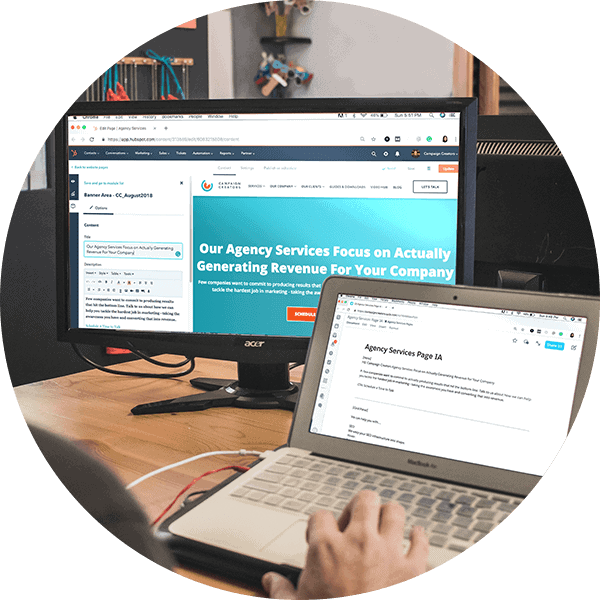5 Key Takeaways from INBOUND 2017
October 6, 2017
Do You Feel Like You’re Failing at HubSpot?
October 27, 2017
We’ve talked a lot recently about all the work that goes into Inbound Marketing, from the initial research and strategy development to actually executing all the many, many moving pieces. One thing we’ve alluded to, but not really discussed yet, is analysis, reporting, and adjustment.
Inbound Marketing relies heavily on marketing automation, so it may seem a bit paradoxical to have to stay so hands-on throughout the entire process, but the reality of the situation is that Inbound Marketing is not a Crock-Pot—there is no set-it-and-forget-it option!
Reporting and analysis are vital parts of your marketing strategy—parts that are easy to overlook—and they are the corners that are the easiest to cut when your marketing manager is overwhelmed.
You can drive and drive all day long, but if you’re not following your map, you could have taken a wrong turn 6 hours ago and ended up somewhere completely different from your intended destination—and you’ve wasted a lot of time and gas.
Inbound Marketing works the same way. You can spend tons of time developing personas, identifying goals, and creating and executing a strategy, but if you’re not generating the leads, then all that time and effort is wasted.
To keep your marketing strategy rolling on the track that will accomplish your goals, you must stop and evaluate your progress at regular intervals, figure out what’s working and what isn’t, and adjust your strategy.
The following issues are signs that you need to correct your course before you go too far off track:
Your Paid Ads Are Not Getting Clicks
Paid advertising is the best way to jumpstart your traffic and get some quick leads coming in while you do the slower work of growing your organic traffic. Fortunately, it’s pretty easy to spot it if something isn’t looking right with your paid ad performance. While high bounce rates (think 80-90%) are not uncommon with paid ads, it is worth looking at to see if you can pinpoint what users think they’re getting versus what they’re actually getting. Where’s the disappointment?
Additionally, you want to keep an eye on things like:
- Ratio of clicks to impressions
- Ratio of impressions to searches
- Search volume by location
- Relevant vs. irrelevant keywords
Once you get used to looking at these numbers on a regular basis (think monthly), you’ll be familiar with your own benchmark data and will be able to quickly notice if anything looks amiss, and you can use that knowledge to improve your ROI.
Your Organic Traffic Is Not Trending Upward
This one is a tricky one that comes with some disclaimers. There are a lot of factors to be considered when you’re looking at your organic traffic—it’s not unusual for a brand-new site to take up to 12 months to really start seeing significant organic traffic.
In spite of this, when you’re looking at your sources report, you should start seeing an upswing over the period of a few months. The numbers may not look like what you were expecting, but the graph should at least be moving the right way.
If you’re looking at a 6-month spread, and your traffic is stagnant—or even trending downward—you need to take a closer look at what you’re doing. Maybe you’re not doing enough. Maybe you’re spending too much time on tactics that aren’t working for your industry or company, and you need to reallocate some of your resources. Maybe you’re simply targeting the wrong keywords—you’re ranking well, but not for what your market is searching for.
Your Social Posts Are Getting No Engagement
It’s common to take a dismissive attitude toward social media, especially when it comes to its relevance to a business, but this is a mistake, and one that can be costly. Social media is where your market gets its information, and it is the tool that puts power back into the hands of the consumer. It’s where their voice gets heard, for good or for ill. It’s where they can hold companies accountable for bad service, and where they can sing the praises of good service. Don’t make the mistake of thinking social media engagement won’t impact your bottom line!
Social media platforms like Facebook, Twitter, and LinkedIn have been around long enough that most of their users are pretty savvy, and they have their favorite platforms set up to deliver the content they want to see. If your social posts are just sitting out there and getting very little engagement, what your users are telling you is that your content offers them no value. Your message isn’t cutting through the noise. They don’t have any use for what you’re posting.
That’s why it’s so important to have a strategy and weave your social media posting in throughout it. This is a powerful opportunity for you to get your most valuable, useful content into the hands of your consumers. If you’re getting no engagement, you need to take an honest look at questions like
- Do your posts truly offer any perceived value?
- Are your posts helpful? Are they unique?
- Is your message powerful?
- Are you offering the right content in the right places?
- Do you sound authentic?
- Are you following best practices to make your activity as effective as possible?
Your Social Engagement Is Not Leading To Referral Traffic
The second purpose behind social media posting is to drive users back to your website so that your site can do its job of converting those users into clients. While it’s important to share content from other industry experts, you also need to be sharing content that links back to your own site. If you’re looking at your sources report and you’re not getting referral traffic from social media, you could be missing out on valuable prospective business.
Your Emails Aren’t Performing Well
Email marketing is easily the most cost-effective way to stay top of mind with your audience, so if you’re seeing low open rates (25% is pretty good), low click-through rates, or you’re getting a lot of unsubscribes or spam reports, you need to turn that around pretty quickly.
Email is especially important for middle-of-the-funnel—or consideration stage—lead nurturing. If you can’t reach existing prospects, you’re going to lose some serious opportunities.
Your Site Isn’t Being Indexed Properly
Technical SEO issues can crop up at any time, and for seemingly no reason at all. Things to monitor include:
- Crawlability issues like your robots.txt and .htaccess files, working links and redirects, etc.
- Site architecture
- Updates to CMS platforms and plugins
- Page speed
- Mobile friendliness
- HTTPS implementation
- Toxic backlinks
- On-page SEO factors: alt text, H tags, meta descriptions, etc.
With so many moving pieces, it’s easy for weird things to happen. If you’re not running audits on these areas, your site can start slipping in rankings — or worse, get blacklisted! Make sure you’re taking the time to maintain a healthy website.
You’re Simply Not Getting The Leads
Sometimes, you put loads of work into Inbound Marketing and after a few months, you’re just not getting the leads you were hoping for. It’s discouraging, and can make you feel like you’re wasting your time.
While it’s true that there are a few industries that Inbound Marketing isn’t a great fit for, we don’t find it to be especially common. When you’re not getting the leads, it doesn’t mean you failed. You simply need to analyze and refocus.
Maybe your buyer personas are off or you’re not nailing your messaging. Maybe you’re targeting the wrong keywords, not answering the right questions, or maybe you’re simply not offering enough value.
Sure, it can be frustrating to feel like you need to reevaluate your whole strategy, but if you do, at least you have an advantage that you didn’t have the first time—now you have data. Now you can analyze your funnels and figure out where you’re losing people. Are you getting the traffic you need? If so, are your CTAs compelling? Maybe your sales team just isn’t closing the leads that are coming in. Analyzing your funnel performance will give you the insights you need to close the gaps and convert your users into buyers.
Looking For Inbound Marketing Help?
If all of this analysis, adjustment, and iteration seems like it’s just too much to keep up with, maybe it’s time to consider partnering with an agency like Waypost. For the cost of one qualified in-house marketing employee, you could outsource all of your digital marketing to an entire team of experienced professionals dedicated to the growth of your business.
If this sounds like something you want to explore, give us a call at (864) 288-6162.









